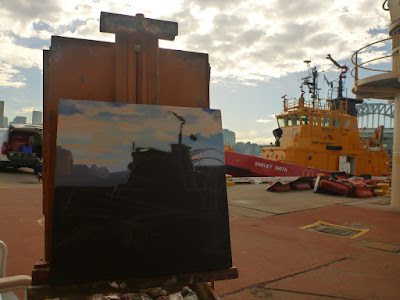Although I’d been Artist in Residence’ at the East Darling Harbour Wharves, and even in the Harbour Control Tower for almost a decade, it wasn’t until July 2011 that I was invited to become Artist in Residence’ at Moore’s Wharf, the Sydney HQ of Sydney Ports Corporation.

MW 1'Cleaning the boom in front of the 'Shirley Smith'
2011 oil on canvas 31 x 31cm
Available for sale
The East Darling Harbour Wharves finally closed in October 2007.
I managed to keep access to the wharves during the demolition of the wharves & even during the early stages of the construction on Barangaroo.
I even retained occasional access to the Harbour Control Tower after April 2011 when it ceased to be used for maritime operations by Sydney Ports Corporation.

MW 1'Cleaning the boom in front of the 'Shirley Smith'
2011 oil on canvas 31 x 31cm
Available for sale
Moore’s Wharf is a handsome 3 storey sandstone warehouse that was originally built in the 1830s by convict labour.
There are still some convict marks, such as arrows on some of the sandstone blocks which were quarried locally.
The surrounding suburb, Millers Point, is built on a ridge of yellowblock sandstone that is of high quality, although not quite up to the standard of the famous Pyrmont yellowblock.
Bizarrely, the entire building was moved stone by stone, a few hundred metres to its existing position, when the adjoining wharves were extended and redeveloped for containerization.

MW 1'Cleaning the boom in front of the 'Shirley Smith'
2011 oil on canvas 31 x 31cm
Available for sale
In front of Moore’s Wharf, Sydney Ports Corporation has two highly visible, verging on garish, bright scarlet and yellow firefighting tugs, the ‘Shirley Smith’, and the ‘Ted Noffs’. They are part of a fleet of emergency response vessels and specialised equipment used for fire-fighting, oil spill response, salvage and providing assistance to stricken vessels.
The marine operations teams work closely with Fire and Rescue NSW to prepare for fighting fires which may not be accessible to the fire teams by land.

MW 1'Cleaning the boom in front of the 'Shirley Smith'
2011 oil on canvas 31 x 31cm
Available for sale 
MW 1'Cleaning the boom in front of the 'Shirley Smith'
2011 oil on canvas 31 x 31cm
Available for sale
The East Darling Harbour Wharves finally closed in October 2007.
I managed to keep access to the wharves during the demolition of the wharves & even during the early stages of the construction on Barangaroo.
I even retained occasional access to the Harbour Control Tower after April 2011 when it ceased to be used for maritime operations by Sydney Ports Corporation.

MW 1'Cleaning the boom in front of the 'Shirley Smith'
2011 oil on canvas 31 x 31cm
Available for sale
Moore’s Wharf is a handsome 3 storey sandstone warehouse that was originally built in the 1830s by convict labour.
There are still some convict marks, such as arrows on some of the sandstone blocks which were quarried locally.
The surrounding suburb, Millers Point, is built on a ridge of yellowblock sandstone that is of high quality, although not quite up to the standard of the famous Pyrmont yellowblock.
Bizarrely, the entire building was moved stone by stone, a few hundred metres to its existing position, when the adjoining wharves were extended and redeveloped for containerization.

MW 1'Cleaning the boom in front of the 'Shirley Smith'
2011 oil on canvas 31 x 31cm
Available for sale
In front of Moore’s Wharf, Sydney Ports Corporation has two highly visible, verging on garish, bright scarlet and yellow firefighting tugs, the ‘Shirley Smith’, and the ‘Ted Noffs’. They are part of a fleet of emergency response vessels and specialised equipment used for fire-fighting, oil spill response, salvage and providing assistance to stricken vessels.
The marine operations teams work closely with Fire and Rescue NSW to prepare for fighting fires which may not be accessible to the fire teams by land.

MW 1'Cleaning the boom in front of the 'Shirley Smith'
2011 oil on canvas 31 x 31cm
You can see the crew in the background next to the Shirley Smith.
The weird crumpled red and black object, that looks slightly like a giant version of the sort of caterpillars found on citrus trees is a boom to enclose oil spills and similar hazards. Booms are kept near the boat, so they can be rapidly deployed. My first painting as ‘Artist in Residence’ at Moores Wharf was of a classic everyday task - the marine operations team cleaning one of the recently deployed booms.

MW 1'Cleaning the boom in front of the 'Shirley Smith'
2011 oil on canvas 31 x 31cm
Available for sale
Shirley Smith was built in 1987 and normally based in Port Jackson, whereas the ‘Ted Noffs’ is usually stationed at Port Botany, although occasionally both are there when I've been painting. They are manned 24/7, 365 days a year. They each have a capacity for delivering 16,000 litres of water per minute. As well as emergency response to fires, this water spray is also used for spectacular displays during celebrations such as New Year’s Eve, and to welcome the ‘maiden call’ of a ship into Port Jackson.
The tug was named in honour of Shirley Smith (Mum Shirl), an Aboriginal woman who dedicated her life to welfare services.
Related Posts
The tug was named in honour of Shirley Smith (Mum Shirl), an Aboriginal woman who dedicated her life to welfare services.
Related Posts
Painting the 'Poolya' at Glebe Island


No comments:
Post a Comment